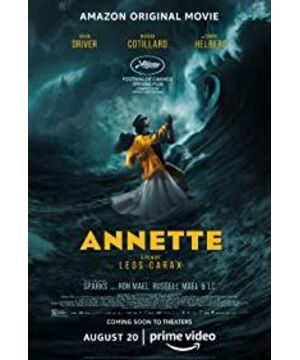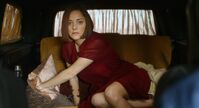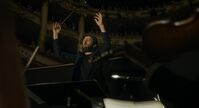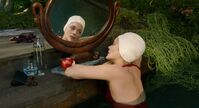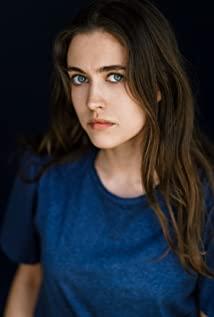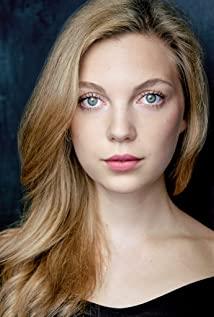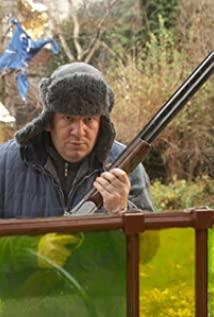Pull-Out Explanation of Karax Movies
This article was first published on the WeChat public platform "Movie1958" (movie1958) Unauthorized reproduction is prohibited
After images of street corner buildings and sonic tracks overlap, the red bus passes by, and then Leo Calax sits at the mixer, lighting a cigarette.
This is the opening paragraph of Annette (2021). These two shots are enough to make any viewer who really loves Karax's films feel an intuitive, physiological, as if re-encountering the joy of food that has been lost for many years, and looking forward to eating, full, and aftertaste. process.
As early as the beginning of the story of "Bad Blood" (Mauvais sang 1986), after a black and white video of a swan, a running subway passes in front of the camera, and a man with short gray hair stands in front of the door of the car. He gave us a long back view, and the smoke seemed to be coming out of his mouth.
Up to now, with stroboscopic waveform images, intermittent mechanical noise, and unstable exposure ratios, Karax points to the two ends of the "movie" by means of multi-layer composite images:
The latter clearly heralds the beginning of the experimental film form, the montage within a single shot brought about by Vertov's overlapping images, which appears in "Annette" with extreme density; the former clearly articulates cinema as a continuity , the opposite of immersive art, glitch art.
In the past, the fluttering of swans and obvious film drops and scratches, like Pola X (1999), which used a crude war video as the opening to the story, was the usual way to find footage.
Not to mention the more familiar "Holy Motors" (Holy Motors 2012), the choice of the research material of human movement at the beginning of the birth of photography and the names of the cast and crew appear alternately, and the rhythm of the repeated editing is difficult to avoid. Reminds me of Mechanical Ballet.
Or to put it another way, when faced with the short films Naked Eyes 2010 (Naked Eyes 2010) or Untitled (Sans Titre 1997), one would suddenly think that Godard was wrong.
After some kind of argumentative retrospection of avant-garde creations, a glimpse of the bus or subway transitions, and then the characters appear in the back, with a cigarette beside the scene.
In his films, we cannot ignore those repetitions.
Such as a lot of motorcycles, cars, roads. At the end of Bad Blood, Alex (Denis Lawan) is shot over the engine at the front of the car, Lisa (Julie Delpy) arrives on a motorcycle, Anna (Juliet Binoche) running on the empty highway; we were even more impressed by the constant presence of subjective moving shots that seemed to simulate a third perspective inside a car that didn’t exist on the screen.
If we go back to the physical properties of vehicles, they complete the double change of time and space through motion. And the characters in the movie, whether it is a scene or an emotion, just need a practical carrier through the principle of transport and editing.
Also such as a lot of back. The mysterious appearance of Alex (Denis Lawan) in "Lovers at Pont-Neuf" (Les amants du Pont-Neuf 1991), and the backside of facial expressions that hide more information, carry more. Emotional passages.
As for cigarettes, Karax has made it clear in his short film "My Last Minutes": Stop smoking, it is better to stop life.
Stand-up comedian Henry (Adam Driver) enters the stage from backstage, passing through a small space filled with smoke. The smoke imparts a ceremonial quality that refers to the path of expression, performance, film, and life.
music tentacles
If "Annette" were to be defined simply, it would be classified as a "musical".
For viewers familiar with Karax's films, this may be a predictable and inevitable direction for him. He even said, "Actually, what I want to do may be music rather than movies."
The first song of the film, "So May We Start", was led by the Sparks out of the studio, and the backing actors entered the queue one after another from outside the frame. This tension-filled long shot is reminiscent of the accordion version of Let My Baby Ride from Sacred Car Dealers. Denis Lawan entered the church, and accordionists kept joining, followed by harmonica, guitar, drums, in a marching band.
This three-minute, seemingly abrupt "interlude" brings a higher meaning to "Sacred Car Dealer".
Music is an integral element of Karax's films. However, unlike others, he prefers to use music in large sections, pushing it to the forefront of the screen.
A melody from Serge Gainsbourg in Boy Meets Girl (1984) appears in the opening scene where the woman drives away from her husband with her child and skis;
As well as "Modern Love" from David Bowie in "Bad Blood" and "Strong Girl" from Iggy Pop in "Lovers in New Bridge", which are matched on the screen respectively It's two parts that people talk about: Alex's run around the block, and Michelle (Juliet Binoche) dancing wildly under the fireworks.
The poster of "Annette" even chose the waltz on the plywood of the ship in the storm. The mood of Henry, who was already drunk in the film, was released to the greatest extent in this scene.
But can the transmission of emotions be completed only by relying on a moment of physical catharsis? Fluctuating and violent emotions are easily dissolved in the still and silent auditorium.
After repeated pulling work, I found that Karax is a director who can mobilize and use the body to the greatest extent. In his films, the shots of hands and feet are the most important part of laying out the emotions.
For the former, it lays a solid foundation for the Bressonian, telling of connection: the chain of relationships between people and objects, or between people.
For the latter, it will eventually lead to a journey of stepping, marching, running, dancing, and even faster, motorcycles, cars, yachts.
The limbs become an extension of the emotion.
In Karax's films, the body is how he touches and perceives the world: in Henry's comedy in "Annette," he concocts a wife-killing story in a tone we can't tell if it's serious or not: scratching Death of the sole of the foot.
And back to the music, in the end, the two are combined into a form of "singing and dancing".
The camera revolves around the conductor (Simon Helberg), and in the music, several passages of speech that should not appear as lines are placed in the gap between the high-pitched melody, and the pause of "wait a moment" is just like him. When telling the story of the past, the heart pounded, choked to the urgent need to calm down.
The turbulent music simulates an extreme and straightforward auditory externalization of inner emotions.
film deconstruction
Going back to our classification of "Annette" in terms of genre, if we want to conclude that it is a "musical film" that replicates the Hollywood industrial system, or "The Umbrella of Cherbourg", then it should attract a lot of criticism. . So much so that some film critics commented "the most ugly" and "no feeling at all".
Of course, this is very narrow.
Before the film begins, there is a very important passage: the noise fades out, followed by the clapping of the microphone, and the male voice in the black field comes from the speaker: "Ladies and gentlemen, please pay attention... Please keep quiet. , hold your breath until the very last moment of the show."
This is a delicate echo of the "curtain call" after the film as a "story" is all over.
All the cast and crew walked down the hill with lanterns, and they read "If you like this movie, tell a friend about it...Good night everyone"; "Puppets, tape sticks, cameras march with the procession.
Compared with the discussion of "watching" and "acting" with a character named "Oscar" in "Holy Car Dealer", Karax draws "what is a movie" more clearly in "Annette". A solid line:
During the march of the first song, Adam Driver and Marion Cotillard put on the costumes arranged for the characters in the play, walked into the theatrical situation of the film, and went to the scene of the performance respectively.
As a result, the marriage story of Henry and Ann told in the film has obviously become a blatant "show" belonging to the director. As audiences, we are told of its falsity, and the "movie" is completely deconstructed of its established logic.
At the same time, in the process of watching "Annette", we gradually discovered that there are few non-sung lines in the film, and the melody is even more simple, light, and repetitive, not catchy enough, or even pleasing to the ear.
It is said that when working on the song, Karax chose to pick up the sound directly on set, rather than the traditional way of matching the perfect soundtrack from the studio when performing. As a result, even the daily actions of going to the toilet, lighting a cigarette, etc. give the song a lot of pause and breath dynamics.
Even if "musical film" becomes the inevitable trend of Karax, "Annette" also tries to blur the boundaries between lines and lyrics, life and dancing. What he deconstructs is "movie" itself, but also "music".
Passionate
In Karax's films, he uses one color throughout: "Mr. Dung" in a green suit in Tokyo! "(Merde 2008) "Hymn to Merde" (Hymn to Merde 2008) "Holy Car Dealers" three times until Henry McHenry's green bathrobe.
"Mr. dung" is called "Merde", which is regarded as a swear word that has no practical meaning in the French context, and can be roughly paralleled to "shit" in English. The eccentric madness of "Mr. Dung" is also the best way to understand the "infamous" Henry's "aggressive" performance.
We can't help but admit that Denis Lawan, who has worked with Karax in seven films, and who is similar in age, size and image, is not an Antoine-esque expression by the director, not to mention that these roles are all given to them. Had the same name: Alex.
In Annette, Ann appears several times with the apple as an image. Henry used her, possessed her, murdered her, just as he did with desire.
And Henry is precisely the self-mirror that Carax has given birth to after experiencing all kinds of crazy indulgence, mania, and darkness. He used the purple block on Henry's face as a metaphor for the trajectory of his life, and in prison he said "I am standing in front of the abyss".
To our heart's content, "Annette" is an unimaginably brave self-disclosure. Unlike other films, Annette's final song, "Sympathy for the Abyss," is full of introspection, remorse, and apology.
Such apology, Karax also told frankly at the end of the film: This film is dedicated to his daughter Nastya. He gave Annette the softest melody, and finally took away some of the spookiness of the marionette, and returned her existence and willpower.
This kind of warmth has never been seen before, the opposite of the once strong and fierce.
However, due to its cinematic and even formal nature, Annette's refusal to formulate and reckless behavior is destined to be appraised by extreme polarities. "Never the best"? So, does Carax care?
The answer seems to be no.
He also seems to have always been a seemingly "lonely filmmaker". He once said, "The filming started like a fraud." We also understand that this expression is entirely his own, but we can't help but judge from the outside.
View more about Annette reviews


